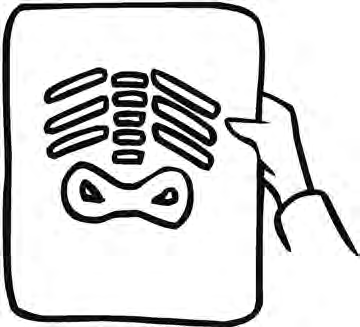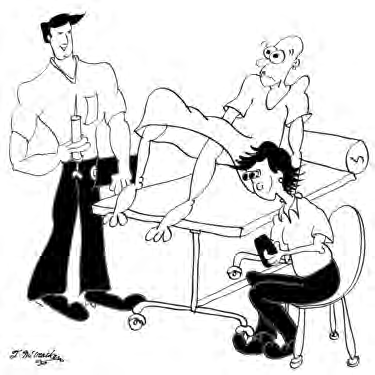100 Perks of Having Cancer: Plus 100 Health Tips for Surviving It (55 page)
Read 100 Perks of Having Cancer: Plus 100 Health Tips for Surviving It Online
Authors: Florence Strang
Tags: #Health; Fitness & Dieting, #Diseases & Physical Ailments, #Internal Medicine, #Oncology, #Cancer, #Medicine & Health Sciences, #Clinical, #Medical Books, #Alternative Medicine, #Medicine

around us and even inside our own bodies. Our blood and bones contain
potassium 40, carbon 14, and radium 226. There is also radiation that
comes naturally from the soil and the air, which finds its way into our food.
Basically, there are two types of radiation out there: nonionizing radiation
and ionizing radiation.
Nonionizing radiation
refers to waves that travel through the air but do
not have enough energy to damage atoms and, ultimately, living cells. Some
types of nonionizing radiation include electromagnetic (that is, from power
lines), microwaves, radio waves, and infrared waves. This form of radiation
can do damage, but it is in the form of heat damage (heat burns), not cell
destruction and possible cancer.
Ionizing radiation
includes x-rays, gamma rays, and UV rays (solar), and

Perk #56: A Surprise Visitor
225
this is the type of radiation present when we think of nuclear radiation. Ion-
izing radiation causes damage to the body’s cells and can cause cancer. We
aren’t aware of exposure to these types of rays unless we agree to a CT scan
or nuclear medical test or we bake in our bikinis (and I don’t mean cook-
ies). This type of radiation is cumulative—that is, exposure adds up over
your lifetime. It is also all around us in the environment.
So how much is too much? When we talk about “damage” and “harmful
radiation,” we want to know
how much radiation can I get and still be sure I
won’t grow another pinky finger.
There are many ways of measuring radiation. For the purpose of conti-
nuity, I will use the unit “millisievert” or mSv. You may also hear of “rems”
or “rads” when reading or hearing about radiation. They are all different
ways to measure radiation, but it all means ionizing radiation.
We know from Japanese victims of Hiroshima, unfortunately, that sud-
den exposure (all at once, not over the course of a lifetime) to various levels
of radiation produces the following effects:
●
500 mSv—nausea
●
700 mSv—vomiting
●
750 mSv—hair loss in one to two weeks
●
900 mSv—diarrhea
●
1000 mSv—internal bleeding
●
4,000 mSv—death within two months
●
10,000 mSv—death in one to two weeks
●
20,000 mSv—death within hours
So we know what levels are harmful, but it’s a bit trickier to determine
what levels are “safe.”
The general population is exposed to about 3 mSv/year through building
materials, radon, soil, and foods grown in that soil. We know that these
constant low levels of exposure are not harmful or the world’s cancer rate
would be 100 percent.
226
100 Perks of Having Cancer
But what about diagnostic medical testing? I agree that safety must be a
priority, but the risk has to be weighed against the benefit. When considering
a medical diagnostic test, for example, is it really safer to forgo a mammogram
(0.7 mSv) once a year because you are worried about radiation exposure?
CT scans can expose your body to 20 to 40 mSv at a time. If you have
repeated CTs and have significant radiation exposure from other tests, this
could put you at risk of developing cancers later in life. There are situations
where repeated CTs are necessary, but unfortunately (in the United States)
doctors are so “lawsuit conscious” that they often go overboard with diag-
nostic testing, checking and rechecking to make sure they haven’t missed
something that could lead to a lawsuit down the road.
Researchers found a population of 25,000 Japanese post-atomic-bomb
survivors who were exposed to roughly the same amount of radiation as
two CT scans. Based in part on those studies, the Food and Drug Adminis-
tration estimates that an adult’s lifetime risk of developing radiation-
induced cancer from one CT scan is roughly 1 in 2,000. The risk for children
is higher because kids are more sensitive to the harmful effects of radiation
because they are still developing.
When considering a CT scan or any diagnostic test that uses radiation,
you need to ask yourself (and ask your healthcare provider) “is this really nec-
essary,” and “is there another test such as an MRI or ultrasound tests that
would give the same information as a CT scan without the radiation.” MRIs
and ultrasounds do not use any ionizing radiation, and when looking at soft
tissue in the body, they can give the same information (most times) as CT
scans. MRIs are a bit pricey, while ultrasounds are a bargain in comparison.
You can use a handy Radiation Risk Calculator at www.xrayrisk.com to
check the levels of radiation of different diagnostic tests and to calculate
your risk of cancer from the tests that you have had so far. Have fun!
Please note that any radiation treatment for a specific cancer tumor
(excluding Hodgkin’s disease, non-Hodgkin’s lymphoma, or other cancers
in which large areas are treated with radiation at once) may not be included
in your lifetime overall cancer risk but may put you at risk for other condi-
tions such as heart disease (if the left breast was radiated) or soft tissue can-
cers like sarcomas. You should check with your radiation oncologist for the
specific risks that pertain to your cancer and area of treatment.
Perk #56: A Surprise Visitor
227
Cell phone radiation is composed of nonionizing radio frequency radi-
ation. This is the type that can produce heat, like from a microwave. How-
ever a team of thirty-one scientists from fourteen countries, including the
United States and Canada, after reviewing up-to-date studies on cell phones
and cancer risk, found an increase in certain types of brain tumors in those
with long-term cell phone use. You may see articles giving you the “SAR”
or specific absorption rate for certain cell phone models. SAR is the unit of
measure that was given to cell phone radiation. But it doesn’t matter if you
are using the lowest level phone because it all depends on the amount of
time you spend with it pressed against your ear. Using the speaker option
on your phone is always a healthier solution. (But using the speaker func-
tion around
me
would be very bad for
your
health.) Using a Bluetooth device
is another good option as the radiation levels are up to one hundred times
less than from a cell phone.
Since knowledge is power, you would be very powerful if you were aware
of your levels of radiation so that you could make an informed choice before
exposure.
The federal limits of radiation (above the natural 3 mSv/year) are as fol-
lows. These are just limit guidelines. It does not mean that you will get can-
cer if you exceed these limits. Exposure also is affected by a person’s weight.
A larger person would be less affected by 1 mSv than a smaller person (but
that’s
not
a reason to avoid losing weight if you need to).
●
astronauts—250 mSv/year
●
adults—50 mSv/year
●
children under 18—5 mSv/year
●
fetus—0.5 mSv/month (ultrasounds do not emit radiation)
Here is a list of common sources of ionizing radiation and the amounts
of exposure:
●
air travel—0.003 to 0.009 mSv/hour
●
dental bitewing x-rays—0.01 mSv
●
chest x-ray—0.1 mSv
228
100 Perks of Having Cancer
●
cardiac nuclear scan—40 mSv
●
smoking—3 mSv/year (For one pack/day. Tobacco contains radioactive
polonium 201 and lead 210. How d’ya like those cigarettes now?)
●
airport backscatter (full body scan)—0.1 mSv (intentionally
not
getting
into
this
controversy)
●
airport scanner—0.005 mSv
●
normal exposure from environment—3 mSv/year
●
mammogram—0.4–0.7 mSv
●
watching TV four hours/day for a year—0.02 mSv
Radiation could be the source of obsession if you consider all the radia-
tion we come in contact with every day. Don’t obsess or worry if you’ve
already had three CT scans this year, but if there is an option for CT #4 that
does not involve radiation, it might be something worth discussing with your
healthcare provider. Obviously, if the benefits of having the CT scan outweigh
the risk of having one, then you need to take that into account as well.
Please note:
If you plan to do further research (and I hope you do),
remember that 1 mSv is equal to 100 mrem. Some information sites have
incorrect exposure reports because of the different units of measure.
Be aware of your radiation exposure and make
good choices when it comes to your health.




